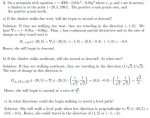Please see attachment for Question.
I have couple of questions about his problem.
First, what does the "due" west mean? away from the west or towards the west?
Second, how do I know if it's asending or desending? My attempt of looking at this is that if the directional derivative or the rate of change of the height of the hill is positive, it's asending; negative, it's desending. But I'm not sure if I'm correct or not. So please tell me if I'm wrong.
Thank you.
PS. My answer for b is: Northeast is in the direction of (1,1) = u. ? Dz(x) = ?z(x) . u where?z(x)=(-0.04x , -0.08y) -> ?z(-20, 5) . (1,1) = (0.08, -0.04) . (1,1) = 0.8-0.4 =0.4. She's asending at the rate of 0.4.
My answer for c is: She can traval along the level curve to be at a level path, which is that the change of the height is zero. Since the function is differenciable, by theorem, ?z(x) . y = 0 where y is a vector that's perpendicular to the gradien and y is the tangent line to the level curve. So one solution for y is (5, 20).
I have couple of questions about his problem.
First, what does the "due" west mean? away from the west or towards the west?
Second, how do I know if it's asending or desending? My attempt of looking at this is that if the directional derivative or the rate of change of the height of the hill is positive, it's asending; negative, it's desending. But I'm not sure if I'm correct or not. So please tell me if I'm wrong.
Thank you.
PS. My answer for b is: Northeast is in the direction of (1,1) = u. ? Dz(x) = ?z(x) . u where?z(x)=(-0.04x , -0.08y) -> ?z(-20, 5) . (1,1) = (0.08, -0.04) . (1,1) = 0.8-0.4 =0.4. She's asending at the rate of 0.4.
My answer for c is: She can traval along the level curve to be at a level path, which is that the change of the height is zero. Since the function is differenciable, by theorem, ?z(x) . y = 0 where y is a vector that's perpendicular to the gradien and y is the tangent line to the level curve. So one solution for y is (5, 20).

